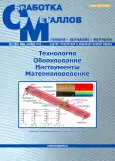1. Shcherbak M.V., Tolstaya M.A., Anisimov A.P., Postanogov V.Kh. Osnovy teorii i praktiki elektrokhimicheskoi obrabotki metallov i splavov [Bases of the theory and practice of electrochemical machining of metals and alloys]. Moscow, Mashinostroenie Publ., 1981. 263 p.2. Arkhipov P.V. Povyshenie rezhushchikh svoistv almaznykh krugov na metallicheskoi svyazke putem ustraneniya ikh zasalivaniya. Avtoref. diss. kand. tekhn. nauk [Increasing the cutting properties of diamond wheels in metal bond by removing them blunting. Author's abstract of Dr. tech. sci. diss.]. Tomsk, 2010. 20 p.3. Yanyushkin A.S., Medvedeva O.I., Arkhipov P.V., Popov V.Yu. Mekhanizm obrazovaniya zashchitnykh plenok na almaznykh krugakh s metallicheskoi svyazkoi [The mechanism of protective films formation on diamond wheel with metal link]. Sistemy. Metody. Tekhnologii – Systems. Methods. Technologies, 2010, no. 5, pp. 132-138.4. Arkhipov P.V., Potapova G.E. Tverdosplavnye materialy i metody ikh obrabotki [Carbide materials and their processing]. Mekhaniki XXI veku – Mechanics of the XXI century, 2012, no. 11, pp. 220-222.5. Lobanov D.V. Sovershenstvovanie tekhnologii zatachivaniya tverdosplavnogo derevorezhushchego instrumenta. Diss. kand. tekhn. nauk [Improving technology sharpening carbide woodworking tools. Dr. tech. sci. diss.]. Bratsk, 2005. 148 p.6. Kuznetsov A.M. Povyshenie effektivnosti frezerovaniya kompozitsionnykh drevesnykh materialov melkozernistym tverdosplavnym instrumentom. Diss. kand. tekhn. nauk [Improving the efficiency of milling composite wood materials with fine carbide tools. Dr. tech. sci. diss.]. Irkutsk, 2009. 217 p.7. Rychkov D.A. Sovershenstvovanie protsessa podgotovki rezhushchego instrumenta pri frezerovanii steklotekstolita. Diss. kand. tekhn. nauk [Improve the training of the cutting tool during milling fiberglass. Dr. tech. sci. diss.]. Irkutsk, 2011. 190 p.8. Medvedeva O.I., Yanyushkin A.S., Lobanov D.V., Arkhipov P.V. Analiz geometrii kontaktnogo vzaimodeistviya almaznogo kruga s obrabatyvaemoi detal'yu pri ploskom shlifovanii [Analysis of the geometry of the contact interaction of the diamond wheel with the workpiece in surface grinding]. Mekhaniki XXI veku – Mechanics of the XXI century, 2013, no. 12, pp. 104-106.9. Nosenko V.A. Vliyanie kontaktnykh protsessov na iznos kruga pri shlifovanii [Influence of contact processes for grinding wheel wear]. Instrument i tekhnologii – Tools and technologies, 2004, no. 17-18, pp. 162-167.10. Shorkin V.S., Frolenkova L.Yu., Azarov A.S. Uchet vliyaniya troinogo vzaimodeistviya chastits sredy na poverkhnostnye i adgezionnye svoistva tverdykh tel [Accounting for the effects of the triple interaction of the medium particles on the surface and adhesive properties of solids]. Materialovedenie – Material Science, 2011, no. 2, pp. 2-7.11. Zamashchikov Y.I. Duality in Metal Cutting: Impact to the Surface Layer Residual Stress. Materials and Manufacturing Processes, 2006, vol. 21, iss. 5, pp. 551-566. doi: 10.1080/1042691050047170612. Yanyushkin A.S., Medvedeva O.I., Yanyushkin S.A., Popov V.Yu. [Physicochemical interaction tool and materials treated with combined electrochemical grinding]. Trudy Bratskogo gosudarstvennogo universiteta. Seriya: Estestvennye i inzhenernye nauki [Proceedings of the Bratsk State University. Series: Natural and Engineering Sciences], 2012, vol. 1, pp. 183-190.13. Yan'kov Yu.V., Osipova A.S., Kuznetsov A.M. Napryazheniya voznikayushchie v oblasti rezhushchei kromki pri zatochke instrumenta [Stresses arising in the field of cutting edge while sharpening tool]. Mekhaniki XXI veku – Mechanics of the XXI century, 2012, no. 11, pp. 274-275.14. Rychkov D.A. Opredelenie perioda stoikosti rezhushchego instrumenta pri frezerovanii steklotekstolita [Definition of tool life during milling fiberglass]. Potentsial sovremennoi nauki – The Potential of Modern Science, 2014, no. 2, pp. 48-52.15. Medvedeva O.I., Yanyushkin A.S., Popov V.Yu. Raschet energii adgezii kontaktnykh poverkhnostei pri shlifovanii instrumental'nykh materialov razlichnymi metodami [Calculation of energy of adhesion of contact surfaces at grinding of tool materials by various methods]. Naukoemkie tekhnologii v mashinostroenii – High Tech in mechanical engineering, 2014, no. 5 (35), pp. 14-19.
 45-50
45-50


 51-67
51-67


 68-75
68-75


 76-81
76-81


 82-89
82-89


 90-102
90-102


 6-13
6-13


 14-20
14-20


 21-27
21-27


 28-36
28-36


 37-44
37-44







